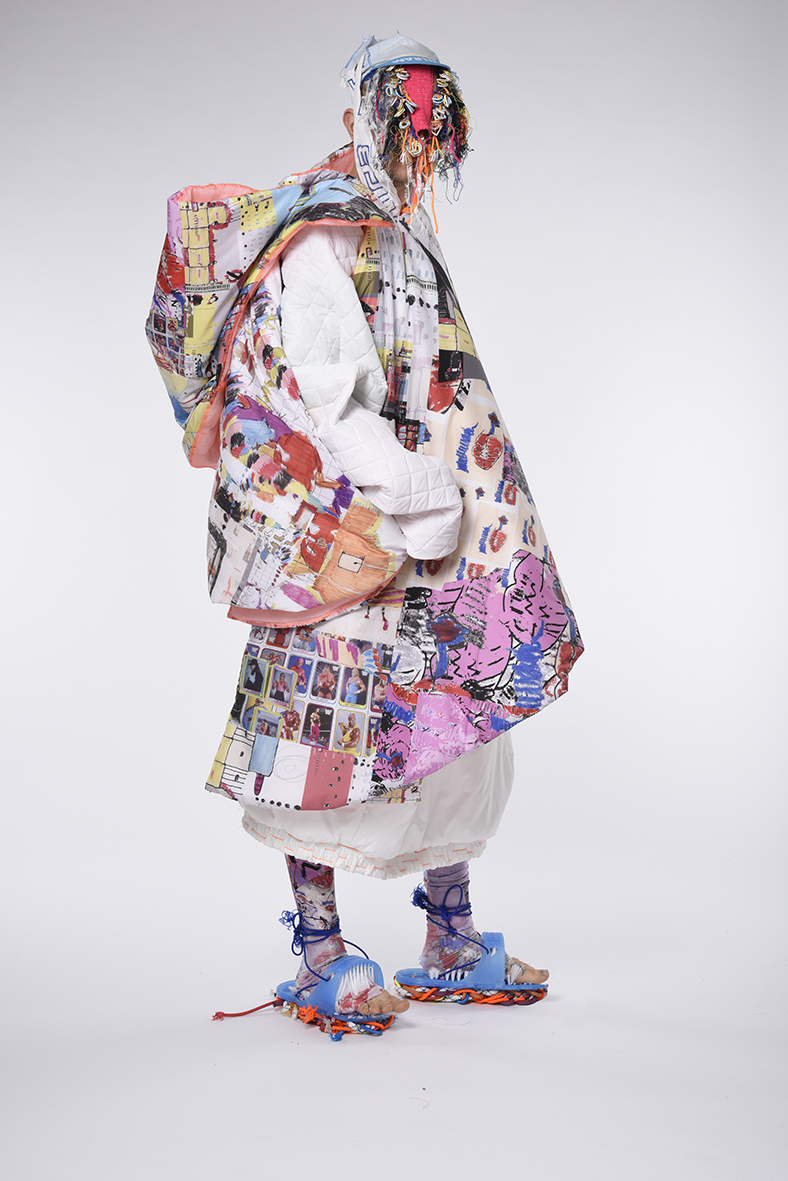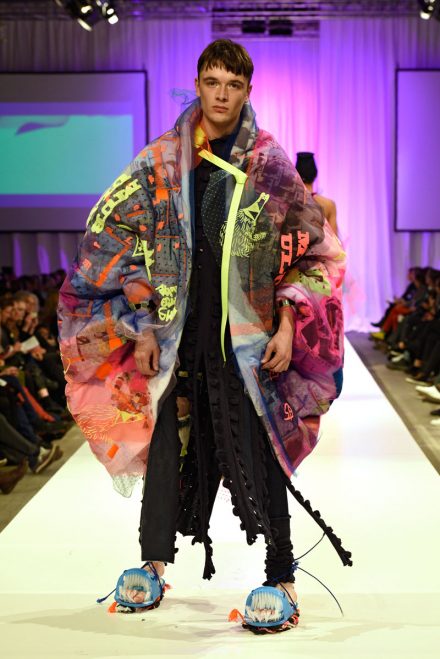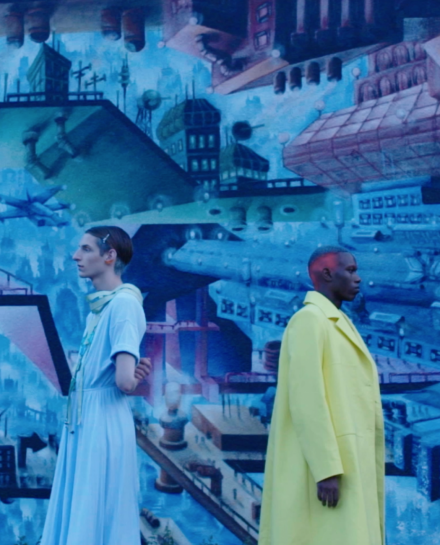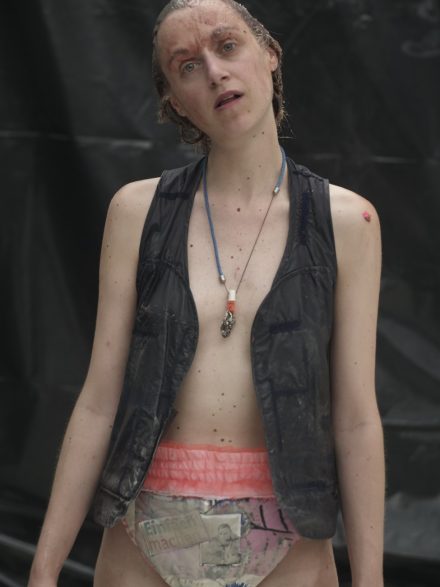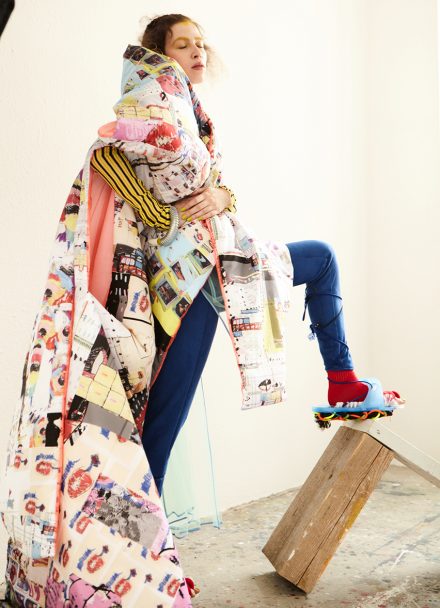With her pink eyelashes and Bernhard Willhelm shoes, Susi Hinz’ appearance is colourful eclecticism in neat form. But perhaps most striking is the extent to which she simply embraces the world in which she finds herself, her expression coming from a distant yet wholly non-judgemental realm. For those keen to dig a little deeper into Susi’s world, her latest collection offers a telling glimpse of her inner-most thoughts, born of deep personal reflection and a resolve to create following nothing but her own intuition. Joining Suzi in conversation were THE VIEW CONCEPTS, an Amsterdam based creative duo dedicated to the blending of pure aestheticism with sociological topics through their relative disciplines of Content Development and Creative Writing. Over the course of their chat they touched upon her living on the bright side of the moon, her views on being in Berlin and her perspectives on our generation.

Source: Susi Hinz
So Susi, you currently call the moon home; where on the moon can we find you?
In a liminal zone, a special area between the bright and dark sides, there where it’s the ideal temperature.
How would you describe this ‘ideal temperature’?
Precisely 9.6 degrees (she says with a stony seriousness). It is an area populated by intriguing creatures and plants, which reflect my space, almost like a mirror. It is neither hot nor cold, but just right.
And why on the moon?
I admire the power of the moon; it has such a profound impact on nature, man and all living things, yet it simultaneously just exists at earth’s side, distant from the sun. From this position, I am able to relate to all that occurs to both humanity and nature; I become aware of how small everything is and things take on new dimensions. But, of all the things that the moon offers, the most important is the space that it allows for dreaming and playing.
What’s the best thing about touching down in Berlin when you are not on the moon?
Its dynamism and the fact that one is always offered options to innovate. In 2014, I completed an internship at Viktor & Rolf in Amsterdam; I noticed that changing and developing in such a city is quite difficult. Here in Berlin you have the possibility to pick a new character for yourself. You are always accepted, as ultimately, nobody cares if that’s what you really want. For me, the anonymity afforded by Berlin is rooted in its architecture; within five minutes you can be in a new zone with a completely different architectural landscape and a diverse spread of faces to match – this makes personal change much easier.
And I also like the trees of Berlin, there are some cool ones at the water upon which you can sit and dip your feet into the Weißensee by night, gazing at the old moon.





Source: Susi Hinz
You create things, you create fashion. How would you describe your designs?
They are honest, playful and exist beyond conventions. I am particularly interested in possibilities and ways and not always having a concrete aim, which is how I perceive both my work and myself. I work consciously, taking my immediate context within society, nature and technology into account; that’s what spurs me on to create ‘hot stuff’ (laughing), to play and to create.
What are you most proud of?
Actually I’m most proud of existing in the here and now. I don’t take things too seriously; I just exist in the moment. This also means making mistakes and reflecting upon them, and even perhaps making more mistakes, but continuing to grow all the while.
It would be reasonable to come to the conclusion that you’re inspired by people’s behaviours. How did this find itself manifested in your recent work?
I spent time pondering over whether nature is chaotic and intuitive or just ordinary, and what impact that might bear on human behaviour. In my opinion, nature is extremely well organised. We are of course part of it – we are made by nature. Our only problem is that we try to play God; this is ultimately our downfall.
My latest work deals with how I relate to this, through expressions of my intuition. To discover how this might appear visually, I began to draw subsequent to a personal experience some time ago. As I drew, driven over and over by nothing but raw intuition, so much was revealed that I was previously unable to articulate.
I didn’t set out with the intention to build a collection around the drawings, but having produced them I noticed something inspiring about their particular visual identities. I wanted to translate these identities from 2D drawings into 3D realities that co-exist with the human body, and so fashion was evidently the most fitting medium to do so. My designs are not humanistic; they are neither gendered, nor do they subscribe to any fashion standards.
They are entities of their own accord, playful and forward – created by a machine, my so-called ‘head-machine’.
When do you challenge yourself the most?
When I’m honest with myself. I’m so close to myself that I know that I’m not close to myself, since I’m always changing. It’s important to just accept that and deal with it; it makes life much easier.
What is your view on our generation?
Our world is like a collage – you can combine everything, everywhere, anytime with everyone – not least because of the Internet. I call the state in which our generation lives: ‘Zeitgeschmackscollage’.
Do you see it as entirely positive, that everything is possible?
Sometimes I do, sometimes I don’t. The very fact that everything is possible can often make decision-making that little bit more difficult. I think it’s extremely important, just as with life, that my work is easy-going, rewarding and, above all, fun.
One particular person once said, “Susi, you are sometimes just too honest”. That’s what it boils down to in the end, and so this is what I try to work with. You can’t constrain things. Things will either happen or they won’t. Simple.
Perhaps this is, to some extent at least, what Raf Simons did in saying goodbye to Dior.
And perhaps it also applies to Helmut Lang, who said “I can’t do fashion anymore”, and now lives in his house dedicating himself to his artwork. My conclusion is that if you’re really doing what you want, there will always be a space for you somewhere in in this wide world.
Speaking of fashion, how would you define this term, and the wider concepts it represents?
Fashion doesn’t exist; it’s simply a tool of measurement, allowing people to easily comprehend and discuss it.

Photo : The View Concept
Susi, last question: can we take a picture of you?
‘No, you can draw me.’
And so we did.

Photo : The View Concept
